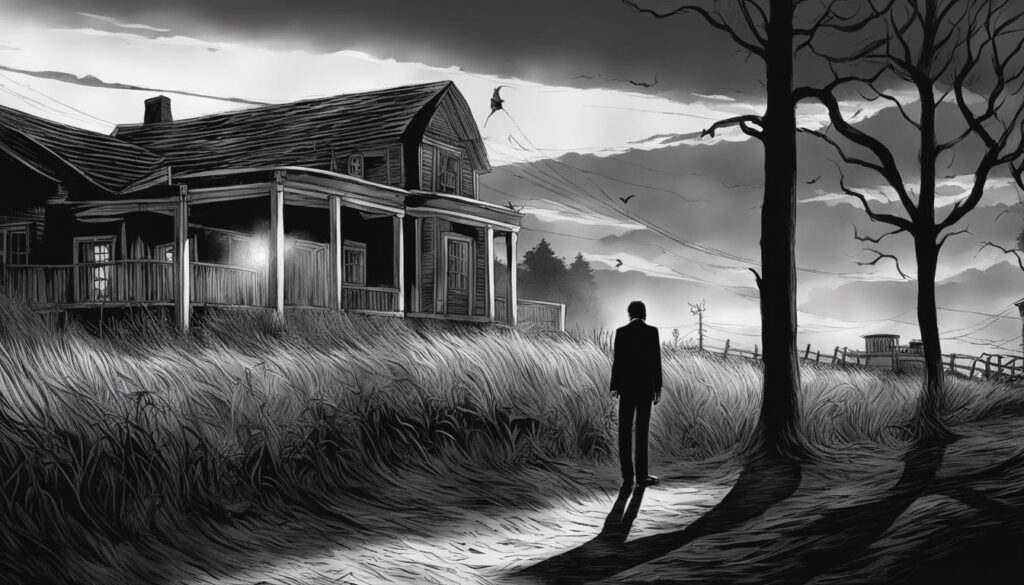Stephen King is known for his gripping tales of horror and suspense, but his foray into graphic storytelling is a unique literary venture that has captivated readers. “The Secretary of Dreams” is a collection of King’s short stories, adapted into graphic format with the help of talented artists.
In this article, we will explore the world of graphic storytelling through the lens of Stephen King’s “The Secretary of Dreams.” From his mastery of the horror genre to the impact of collaborating artists, we will delve into the intriguing intersection of narrative and visual art.
Join us on a journey through the eerie and surreal world of “The Secretary of Dreams.”
Stephen King: A Master of Horror
Stephen King is undoubtedly one of the most influential horror writers of our time. His literary career spans over four decades, during which he has published over 60 novels and countless short stories that have captured the hearts and minds of fans worldwide.
Over the years, King has become synonymous with horror literature, pushing the boundaries of the genre and cementing his place as a master of horror. His unique blend of supernatural suspense, psychological horror, and bizarre characters has kept readers on the edge of their seats, eagerly devouring his latest works.
King’s impact on the world of horror literature is immeasurable. He has inspired countless writers and filmmakers with his compelling storytelling and has played a significant role in shaping the contemporary horror genre. His influence has extended beyond literature, with adaptations of his works appearing in television shows, movies, and even comic books.
Contributions to the Genre
King’s contributions to the horror genre are extensive, with his novels and short stories exploring a variety of terrifying themes, including supernatural occurrences, psychological trauma, and grotesque monsters. His approach to horror writing often delves deeply into his characters’ psychological states, resulting in chilling and evocative tales that have left a lasting impression on readers worldwide.
Literary Career
King’s literary career began in the early 1970s with the publication of his debut novel, “Carrie,” which quickly became a bestseller. He continued to write popular novels throughout the ’70s and ’80s, eventually becoming one of the bestselling authors of all time. In addition to his contributions to horror literature, King has also written in other genres, including science fiction, fantasy, and crime fiction.
Impact on Contemporary Literature
King’s immense popularity has made him a household name and has contributed significantly to the broader literary landscape. He has received numerous accolades, including the National Medal of Arts, in recognition of his contributions to American literature. His impact has extended beyond his horror writing, with his work influencing other genres and contributing to the evolving nature of contemporary literature.
The Secretary of Dreams: Overview
Stephen King’s “The Secretary of Dreams” is a unique anthology that blends his chilling narratives with captivating visual art, creating a one-of-a-kind reading experience. The collection features twenty short stories, each accompanied by illustrations from talented artists such as Glenn Chadbourne and Bernie Wrightson.
The concept behind “The Secretary of Dreams” is to showcase Stephen King’s mastery in not only written storytelling but graphic storytelling as well. The combination of narrative and visual art creates a hauntingly beautiful fusion, adding an extra layer of depth and horror to each story.
King’s Vision:
The anthology is a manifestation of King’s vision to represent his stories visually. He saw the illustrations as a way to add to the already robust storytelling present in his works. Furthermore, he wanted to collaborate with artists whose distinct style and tone would complement his writing and add to the macabre tone of the stories.
The Dark Imaginations:
“The Secretary of Dreams” draws inspiration from King’s dark imaginations, showcasing his wide-ranging approach to storytelling and his unique blend of horror and suspense. It doesn’t aim to limit itself to a specific genre, but rather to offer a diverse experience to readers in terms of themes and imagery.
The Art of Visual Storytelling
Visual storytelling has been an essential aspect of literature for centuries. The combination of striking visuals with narrative has enhanced the reading experience for audiences, allowing them to immerse themselves in the story in a unique way. This has been especially impactful in the world of graphic novels, a genre that has gained popularity in recent years.
Stephen King’s “The Secretary of Dreams” is a perfect example of how visual storytelling can be utilized to create an unforgettable reading experience. The anthology features vivid and intricate illustrations alongside King’s chilling narratives, highlighting the potential for powerful storytelling that the combination of text and visuals can offer.

The impact of graphic novels has been significant, with the genre appealing to a diverse audience. With powerful stories and stunning visuals, graphic novels have earned a place as a respected art form and a unique means of storytelling.
In-depth Analysis: The Secretary of Dreams Stories
Stephen King’s “The Secretary of Dreams” is a graphic storytelling collection that features a variety of his short stories, including “The Road Virus Heads North” and “Crouch End.” In this section, we will take an in-depth look at the stories included in this anthology, analyzing the themes, characters, and narrative techniques employed by King.
One standout story in “The Secretary of Dreams” is “The Road Virus Heads North.” This gripping tale follows the journey of an antique hunter who purchases a painting depicting a gruesome scene of a car crash. As he travels home with his new acquisition, he begins to realize that the painting may have a life of its own, preying on his deepest fears and desires.
Another captivating story in the collection is “Crouch End.” Here, readers are taken on a terrifying journey into a nightmare version of London’s Crouch End neighborhood, where a couple becomes lost and trapped in a place beyond time and space.
Throughout “The Secretary of Dreams,” King expertly weaves together elements of horror, suspense, and mystery to craft compelling narratives that keep readers on the edge of their seats. The combination of storytelling and stunning visuals creates a truly immersive reading experience.
Themes and Techniques in “The Secretary of Dreams” Stories
| Story Title | Themes | Narrative Techniques |
|---|---|---|
| “The Road Virus Heads North” | Loss of Control, Fear of Death, Artistic Inspiration | Unreliable Narrator, Foreshadowing, Symbolism |
| “Crouch End” | Otherworldly Horror, Psychological Distress, Fear of the Unknown | Nonlinear Narrative, Descriptive Imagery, Pacing |
As shown in the table, “The Secretary of Dreams” features a wide range of themes and narrative techniques that make each story unique and captivating. From the fear of death and loss of control in “The Road Virus Heads North” to the otherworldly horror and psychological distress of “Crouch End,” King demonstrates his mastery of the horror genre through this stunning collection.
Collaborating Artists: Bringing King’s Visions to Life
Stephen King’s “The Secretary of Dreams” is a stunning collection of graphic storytelling that wouldn’t have been possible without the talented artists who brought his visions to life. Each story features a unique blend of horror and visual art, creating a captivating reading experience.
One of the primary collaborating artists for the collection is Glenn Chadbourne, renowned for his horror artistry. His contributions to “The Secretary of Dreams” are reflected in the cover art for Volumes One and Two, as well as in various illustrations throughout the books. He brings Stephen King’s eerie narratives to life with his striking artwork.
The collection also features the artistry of Bernie Wrightson, known for his work in comic books and horror illustrations. His contributions to “The Secretary of Dreams” can be seen in the illustrations for “The Road Virus Heads North,” a story that has been adapted into a television episode. His realistic approach to horror gives the story a visceral impact that lingers in the mind long after reading.
Overall, the talented collaborating artists bring a unique style and impact to the collection that expands Stephen King’s storytelling horizons. They showcase how visual art can enhance the horror narrative, leaving a lasting impression on readers.
King’s Influence on Graphic Storytelling
Stephen King’s creative impact has reached far beyond the horror genre, influencing writers and artists in the realm of graphic storytelling.
King’s ability to meld chilling narratives with captivating visuals is a hallmark of his literary career and has inspired others to follow suit. With “The Secretary of Dreams,” King continues to push the boundaries of storytelling and redefine what it means to be a graphic novelist.
King’s influence can be seen in the work of graphic novelists such as Joe Hill, who has followed in his father’s footsteps, and Neil Gaiman, who credits King as one of his early influences.
As the world of graphic storytelling continues to evolve and expand, King remains a driving force, inspiring writers and artists to explore new mediums and push the boundaries of the genre.

The Reception of The Secretary of Dreams
“The Secretary of Dreams” has garnered critical acclaim since its publication, with readers and literary experts alike praising Stephen King’s bold and innovative approach to graphic storytelling. The collection’s unique blend of horror and visual art has captivated audiences, further solidifying King’s reputation as a master of the genre.
Some critics have noted the collection’s ability to evoke a visceral reaction in readers, with its vivid depictions of terror and violence. Others have praised the collaborations with notable artists, whose work enhances the visual impact of the stories.
Despite some mixed reviews, “The Secretary of Dreams” has left a lasting impression on the literary world, solidifying Stephen King’s status as one of the most influential writers of our time.
Exploring the Horror Genre through Visual Art
The horror genre has captivated audiences for generations, drawing them in with its chilling tales and spine-tingling suspense. But what happens when horror storytelling is combined with the power of visual art? Stephen King’s “The Secretary of Dreams” pushes the boundaries of traditional horror storytelling by incorporating stunning visual elements into his narratives.
Through the use of vivid illustrations, King’s stories transport readers into a world where fear is palpable and every turn of the page reveals a new nightmare. These powerful images work in tandem with King’s prose, heightening the horror experience and immersing the reader even further into the story.
With “The Secretary of Dreams,” King showcases the potential of visual storytelling, proving that horror can be just as impactful on the page as it is on the screen. By exploring the intersection of the horror genre and visual art, King has created a unique literary venture that appeals to fans of both mediums.
The Legacy of The Secretary of Dreams
When it comes to Stephen King’s bibliography, no discussion can be complete without mentioning “The Secretary of Dreams.” This graphic storytelling collection represents a major milestone in King’s literary career and has left a lasting impact on the world of horror literature.
First published in 2006, “The Secretary of Dreams” presents a unique blend of horror storytelling and captivating visual art. This anthology compiles various works from King’s career and features collaborations with talented artists such as Glenn Chadbourne and Bernie Wrightson.
Despite its status as a departure from King’s typical narrative style, “The Secretary of Dreams” has become an important part of his body of work. It has inspired new audiences to explore King’s work and has opened up new possibilities for creative exploration.
Looking ahead to the future, the legacy of “The Secretary of Dreams” is sure to continue. With its groundbreaking style and unique approach to storytelling, this anthology will remain a vital and enduring part of the broader world of literature.
Stephen King’s Ongoing Exploration of Different Formats
Stephen King has been a trailblazer in the literary world, embarking on various creative explorations through different formats. King’s venture into graphic storytelling with “The Secretary of Dreams” reflects his willingness to embrace new mediums for storytelling.
King’s literary formats have expanded over time, as he continues to push the boundaries of traditional storytelling. Apart from graphic novels, King has also explored other formats such as audio books, short stories, and novellas.
Through his creative explorations, King has shown that literary formats are not restrictive and there are endless possibilities for storytelling. This has been a testament to his exceptional career spanning over four decades.
Conclusion
In conclusion, Stephen King’s “The Secretary of Dreams” is a captivating venture into the world of graphic storytelling. King’s unparalleled mastery of horror literature is on full display in this anthology, expertly combined with stunning visual art to create a unique and enthralling reading experience.
The art of visual storytelling is a powerful tool in literature, and King’s contributions to the genre have had a significant impact on contemporary literature. “The Secretary of Dreams” serves as a prime example of the ways in which visual elements can enhance storytelling and immerse the reader in the narrative.
From the collaborating artists who brought King’s visions to life to the critical reception of the collection, “The Secretary of Dreams” has left a lasting legacy in King’s bibliography and the broader world of literature. As King continues to explore different formats in his literary career, readers can look forward to more thrilling and innovative offerings from this master of horror.



